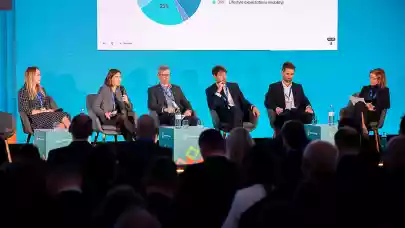
According to Savills, commercial property investment activity hit €2.92 billion across Poland in H1 2020, up by almost 5% on the same period in 2019. Despite COVID-19 challenges, it was the second-best result in the first half of a year on record. Savills anticipates that the pandemic’s impact will be noticeable in H2 2020, but the investment volume is unlikely to fall by more than 20% compared to last year’s all-time high.
Regarding investment by property sector, the office market attracted the most investor capital in H1 2020 (€1.33 billion, down by 20% y-o-y), followed by the warehouse and industrial sector (€1.15 billion, up by nearly 155% y-o-y). The strong performance of the logistics sector marks a shift in investor sentiment towards this asset class over the past few years, says Savills. This phenomenon is gaining steam, among other things, as a result of the expansion of e-commerce accelerated by the COVID-19 pandemic or nearshoring opportunities in Poland. In Q1 2020 alone, warehouse buildings accounted for more than half of the total investment volume, including transactions completed by Savills Investment Management (six facilities with a total area of more than 400,000 sqm) and advised on by Savills.
The sudden economic slowdown brought about by the COVID-19 pandemic impacted yields. Savills estimates that following a correction of 25-50 bps prime office achievable yields now stand at 4.50% in central Warsaw compared to the pre-pandemic 4.25%. A similar correction took place in non-central locations and in regional cities. According to Savills, investors are now significantly more focused on the analysis of tenants and - depending on the tenant’s sector - the risk assessment of a company’s stability may result in another yield correction by additional 15-25 bps. Looking ahead, prime office yields will range in the Polish capital between 4.5%-4.75% until the economy recovers and the ultimate extent of working from home becomes clearer. Savills also notes the small number of transactions in 2020 for prime office buildings in central locations and with long-term leases due to the significant mismatch between buyer and seller pricing expectations.
Prime retail yields moved out by approximately 25-50 bps while industrial yields held firm at around 5% for prime, large single-occupier facilities. Prime industrial and shopping centre yields converged for the first time in history.
“The industrial sector appears to be getting through the pandemic largely unscathed. Its growth outlook remains very positive. The accelerated growth of e-commerce will certainly boost investor demand. There are more unknowns as regards the pandemic’s impact on the office sector. It may lead to market polarisation and concentration of investment capital in prime office buildings that will most likely demonstrate long-term resilience. The difficult period for the retail sector may attract investors who understand changes taking place in this industry and are able to build value in such a market environment. PRS investors received a fresh impetus. Working from home has sparked a discussion about the new dimension to the residential function combined with some aspects of commercial space. Resimercial will be the next buzzword. And finally, the pandemic has demonstrated that there are real estate asset classes whose performance does not depend on footfall levels or employee presence. These include data centres and solar farms. With time, they will join the pool of alternative investments,” says Tomasz Buras, CEO, Savills Poland, and Head of Investment.
According to Savills experts, key factors in the high investment volume in H1 2020 included a favourable economic climate in recent years and the closing of transactions commenced in the pre-pandemic environment. A range of restrictions introduced in mid-March delayed ongoing transactions, with some being mothballed altogether. The consequences of this will also be visible in H2 2020. The market is now showing signs of renewed interest from investors and new transactions commencing. The new deals are likely to close this year provided that there is no need for tightening restrictions in the autumn. Savills estimates that the total annual investment volume in 2020 is likely to be up to 20% lower than last year’s all-time high of €7.8 billion. 2020 will definitely be a favourable year for the industrial sector, which following its strong performance in the first six months of the year began the second half with the closing of a high-profile acquisition of Goodman’s logistics portfolio by GLP.




